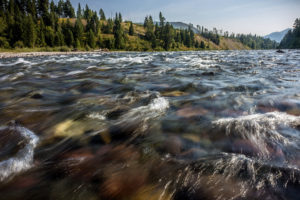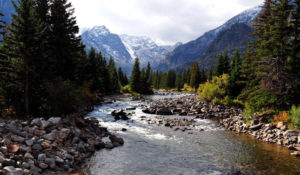The Wild and Scenic Rivers Act turned 50 this month! The act created the first national system to permanently protect free-flowing rivers.
To celebrate, here are ten things you may (or may not know) about Wild and Scenic Rivers.
- President Lyndon B. Johnson signed the Wild and Scenic Rivers Act into law on October 2, 1968, to protect free-flowing rivers with “outstandingly remarkable scenic, recreational, geologic, fish and wildlife, historic, cultural, or other similar values” (Wild & Scenic Rivers Act).
- The first eight rivers protected through the program were all threatened by a dam or mine proposal: Clearwater, Eleven Point, Feather, Rio Grande, Rogue, St. Croix, Salmon, and Wolf.
- The Act has roots on the Flathead River in Montana. Frank and John Craighead, twin brother from Washington D.C., first grasped the importance of free-flowing rivers for wildlife and recreation while studying grizzly bears south of Glacier National Park. The brothers spread the word while fighting a dam proposed on the Middle Fork of the Flathead. Their work lead to clean water protection through the Wild and Scenic Rivers Act.
- Today, the Wild and Scenic Rivers System protects over 12,700 of the 3.9 million miles of river in the country (rivers.gov). All told, this represents a little more than a quarter of a percent of all the nation’s rivers. By comparison, more than 75,000 large dams across the country have altered at least 600,000 miles, or about 17%, of American rivers (rivers.gov).
- A Wild and Scenic designation requires the federal government to protect a river’s free-flowing character, water quality, and remarkable values. However, management decisions on private land are voluntary and agricultural practices, residential development, and other uses can continue.
- Rivers are eligible for three levels of designation: wild, scenic, and recreational. Wild rivers are pristine and generally reached only by trails; scenic rivers are largely primitive, but accessible in some places by roads; and recreational rivers are readily used by road or railroad with some development along their banks.
- Several state and federal agencies manage Wild and Scenic Rivers on public lands, including the United States Forest Service (52%), Bureau of Land Management (21%), National Park Service (17%), States (7%), and Fish and Wildlife Service (3%).
- The three states with the most rivers protected under the act are Alaska (3,210 miles, 25 rivers), California (2,000 miles, 23 rivers), and Oregon (1,917 miles, 59 rivers).
- According to rivers.gov, “Montana has approximately 169,829 miles of river, of which 388 miles are designated as Wild & Scenic—approximately 0.2% of the state’s river miles”. Montana’s three protected rivers are Flathead River (1976), Missouri River (1976), and East Rosebud Creek (2018).
- The Task Force is part of Montanans for Healthy Rivers, a coalition of citizens, sportsmen, businesses, and conservationists, working to conserve the last, best free-flowing rivers in western Montana. In the Gallatin watershed, the Gallatin River, Porcupine Creek, and the Taylor Fork are proposed for Wild and Scenic designations.
Learn more:



